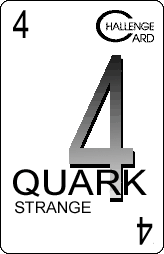Quarks
The Quarks expansion introduces a type of Attack card that changes with time. Careful planning, therefore, becomes somewhat more important.
ADDITIONAL EQUIPMENT:
One "Phase Diagram"--a strip of paper or cardboard with a row of twelve squares printed on it.
| | U + 2 | U + 4 | U + 8 | U + 4 | U + 2 | | U - 2 | U - 4 | U - 8 | U - 4 | U -2 |
| D - 4 | D - 8 | D - 4 | D - 2 | | D + 2 | D + 4 | D + 8 | D + 4 | D + 2 | | D - 2 |
| S + 4 | S + 2 | | S - 2 | S - 4 | S - 8 | S - 4 | S - 2 | | S + 2 | S + 4 | D + 8 |
|
One "State Indicator"--a playing piece of any sort (a coin or paper clip will do).
A whole bunch of "Quark" cards.
To make Quark cards (or "Quarks"), extract three sets of cards from the main deck. Each set should contain the following, based on which version of Cosmic Encounter is being played:
* Eon (no expansions)/West End/Games Workshop--
2 Attack 6's, 2 Attack 8's, 1 Attack 10, 1 Attack 12
* Eon (all expansions)/Mayfair (without More)--
all of the above, plus...
1 Attack 7, 1 Attack 15
* Mayfair (with More)--
all of the above, plus...
1 Attack 4, 1 Attack 9, 1 Attack 10, 1 Attack 11, 1 Attack 13
Mark the faces of all cards in
one set (the "Up" Quarks, or "Ups") with the letter "U", all those in another ("Downs") with a
"D", and all those in the third ("Stranges") with an "S". These cards are now Quarks; depending
on the CE version, there should be 18, 24, or 39 of them.
|
 |
ADDITIONAL SETUP:
Shuffle all Quarks into the main deck before dealing. Place the State Indicator on the first (leftmost) square of the Phase Diagram.
PLAY:
Advancing the Phase State--
At the start of each player's turn, move the State Indicator one square to the right on the Phase Diagram. If the State Indicator is already on the last (rightmost) square, move it to the first (leftmost) square.
Playing Quarks--
Quark cards are Attack cards, and are played in exactly the same manner as regular Attack cards. All rules regarding Attack cards--including the effects of powers, edicts, flares, moons, etc.--also apply to Quarks, except as noted here.
The attack value of a Quark is equal to the number printed on the card, modified according to its "flavor" (i.e., Up, Down, or Strange) and the current phase state. This modification occurs before any other effect or consideration (as if the actual number printed on the card were altered).
To determine how a particular phase state affects a Quark, refer to the Phase Diagram. Look at the square containing the State Indicator; next to the initial of the Quark's flavor (U, D, or S) is the adjustment to be applied to the value on the card. If the initial does not appear in the square, the value on the card is unchanged.
Examples: Suppose the State Indicator is on the fifth square of the Phase Diagram. Then, an Up Quark 10 card (or "Up 10") is considered to be an Attack 14, a Down 12 is an Attack 12, and a Strange 7 is an Attack 3. On the next player's turn, when the State Indicator advances to the sixth square, these same three cards become equivalent to Attack 12, Attack 14, and Attack -1 cards, respectively.
Other Notes--
A Quark is considered identical to an Attack card of its current value. If, for instance, the State Indicator is in the first square of the Phase Diagram and you have a Strange 11 in your hand, and someone plays a Finder edict on you to find an Attack 15, he would get the Strange 11. Had he looked for an Attack 11, however, he'd have been out of luck (unless, of course, you also have an Attack 11).
Quarks do not form another class of cards; they cannot be targeted separately from Attack cards. A player could not, therefore, use a Finder to look specifically for a Strange 11 in your hand. He may wind up getting one, though, as demonstrated in the previous paragraph.
Expansion by Bryan Bowe
|

